Similar triangles
Categories: gcse geometry congruent triangle

Two triangles are similar if they are the same shape, but not necessarily the same size.
Properties of similar triangles
If two triangles are similar, we know that:
- All the corresponding angles are the same.
- All the corresponding sides are proportionate.
Here is an example. These two triangles are similar:
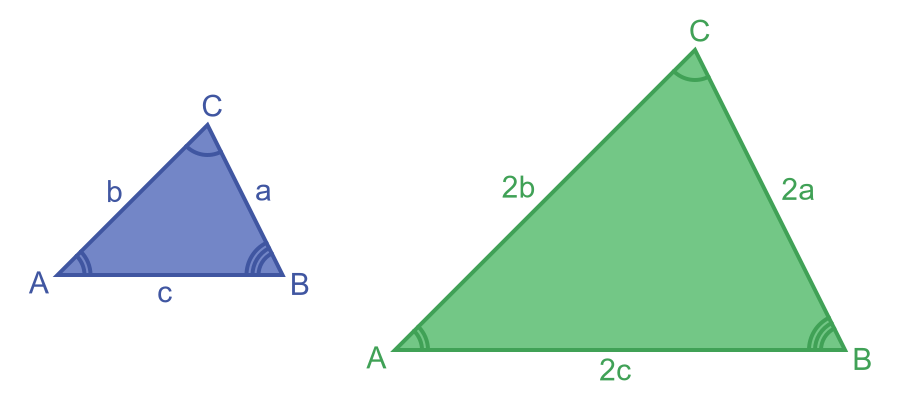
Both triangles have the same angles, A, B, and C.
Each side of the larger triangle is twice as long as the corresponding side of the smaller triangle.
Conditions for similarity
Similar triangles obey the same rules as other similar shapes, but there are a few shortcuts that only apply to triangles.
We don't need to check every side and angle of the two triangles. If some of the sides or angles match the rules below, we don't need to check the rest because they must also obey the rules of similar shapes.
Two rule, the AA rule and the SSS rule, are described here. You can find proofs of these rules here
AA rule (or AAA rule)
If two triangles have two equivalent angles the same, then they must be similar. We don't need to check if the sides are all proportionate because they must be. We call this the AA rule.
Consider this case:

If we choose the two angles A and B, it is impossible to change the shape of the triangle. We can make the triangle bigger or smaller, but we can't change its shape.
The AA is sometimes called the AAA rule - if two triangles have all three angles the same, they must be similar. But since the angles in a triangle add up to 180°, if two angles are the same, the third angle must be the same. For example, if angle A is 30° and angle B is 100°, the third angle must be 50°.
So the AAA rule is exactly the same as the AA rule. If two angles are the same we automatically know the third angle must be the same, so we don't need to check it.
In the case of two right-angled triangles, we already know one angle (the right angle), so if one of the other angles is equal the two triangles are similar.
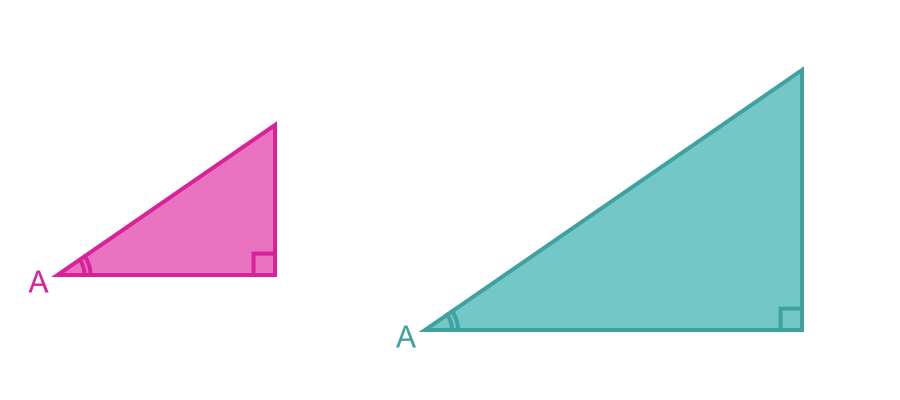
In this case, the fact that they are both right-angled triangles and both have an angle A proves that they are similar.
SSS proportionate
If two triangles have three sides that are proportionate then the three corresponding angles must be equal. This proves that the triangles are similar.
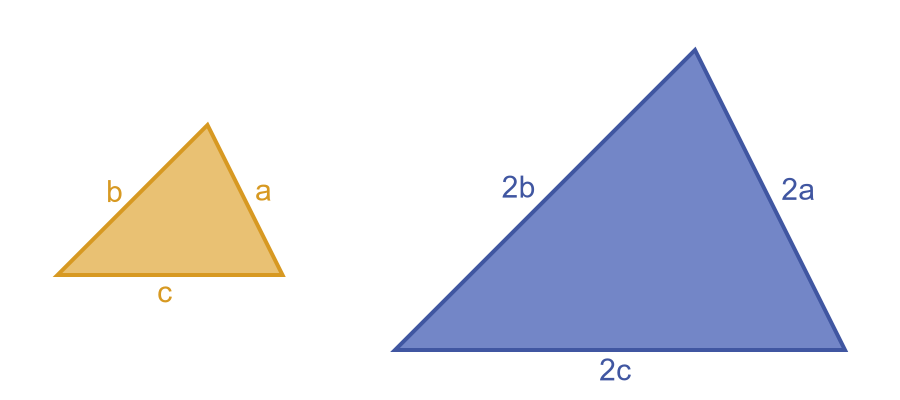
With three proportionate sides, it is impossible to make a triangle with different angles so we don't need to check that the angles are the same. This is called the SSS rule.
Scale factor
For two similar triangles, we can express the size difference as a scale factor.
We can find the scale factor by finding the lengths of any pair of corresponding sides on the two triangles. The scale factor is the length of the side of the large triangle divided by the length of the corresponding side of the smaller triangle.
For example, in the original pair of triangles above, the small triangle has sides of length a, b, and c. The large triangle has sides of length 2a, 2b, and 2c. Taking the corresponding sides a and 2a, the scale factor is 2.
Since we always divide the larger side by the smaller side, the scale factor is always greater than or equal to 1.
The scale factor will be 1 in the special case where the triangles are identical in size, that is when the triangles are congruent.
Examples
Here are some examples of similar triangles.
Equilateral triangles
All equilateral triangles are similar to each other.
All equilateral triangles have three angles of 60°. This makes them similar due to the AA rule.
Triangles based on parallel lines
This diagram shows two parallel lines BC and DE:
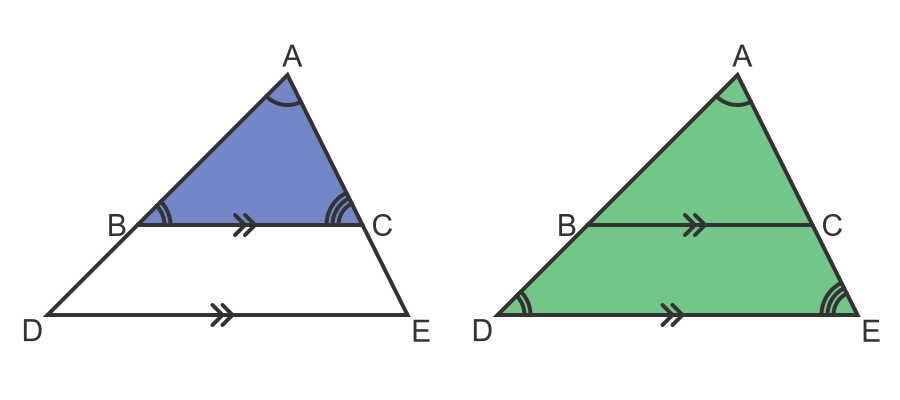
The diagonal lines DA and EA form two triangles - the small triangle ABC in blue, and the larger triangle ADE in green.
These two triangles are similar.
This is due to the rules on angles around parallel lines. The angles at B and D are equal because they are corresponding angles. The angles at C and E are equal for the same reason. Since the two triangles have two equal angles they are similar by the AA rule.
Here is a slightly different situation:
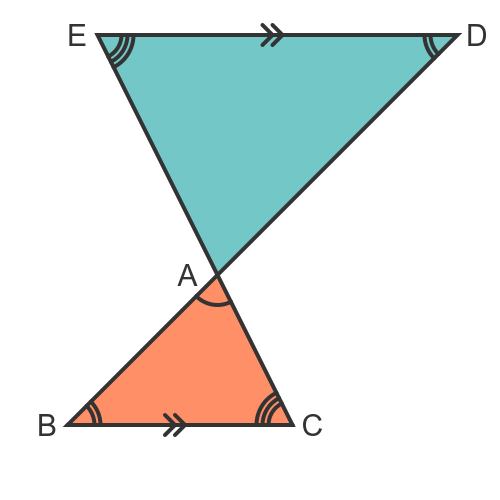
This time the two triangles are formed from two parallel lines and a pair of crossing lines. They are also similar triangles.
Angles B and D are equal because they are alternate angles. Angles C and E are equal for the same reason. Again this makes the triangles similar by the AA rule.
Triangles where two different angles are known
Here is a different situation, where we know two angles of each triangle:
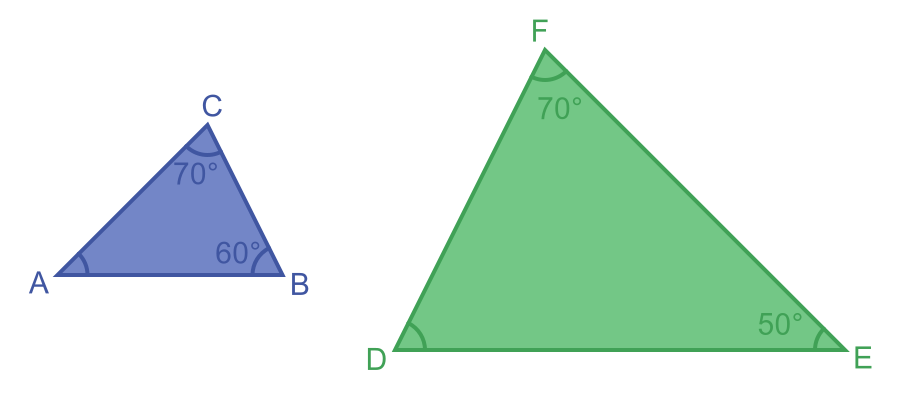
At first glance, these may not seem like similar triangles. However, the fact that they both have an angle of 70° is a clue that they might possibly be similar.
In this case, it is useful to calculate the missing angles. For the triangle ABC, the two known angles are 70° and 60°. These add up to 130°, so the unknown angle A must be 50° so that all three add up to 180°.
This means that angle A equals angle E. And we already know that angle C equals angle F.
So the triangles are similar by the AA rule.
See also

Join the GraphicMaths Newletter
Sign up using this form to receive an email when new content is added:
Popular tags
adder adjacency matrix alu and gate angle area argand diagram binary maths cartesian equation chain rule chord circle cofactor combinations complex polygon complex power complex root cosh cosine cosine rule cpu cube decagon demorgans law derivative determinant diagonal directrix dodecagon ellipse equilateral triangle eulers formula exponent exponential exterior angle first principles flip-flop focus gabriels horn gradient graph hendecagon heptagon hexagon horizontal hyperbola hyperbolic function infinity integration by substitution interior angle inverse hyperbolic function inverse matrix irregular polygon isosceles trapezium isosceles triangle kite koch curve l system locus maclaurin series major axis matrix matrix algebra minor axis nand gate newton raphson method nonagon nor gate normal not gate octagon or gate parabola parallelogram parametric equation pentagon perimeter permutations polar coordinates polynomial power probability probability distribution product rule pythagoras proof quadrilateral radians radius rectangle regular polygon rhombus root set set-reset flip-flop sine sine rule sinh sloping lines solving equations solving triangles square standard curves star polygon straight line graphs surface of revolution symmetry tangent tanh transformations trapezium triangle turtle graphics vertical volume of revolution xnor gate xor gate